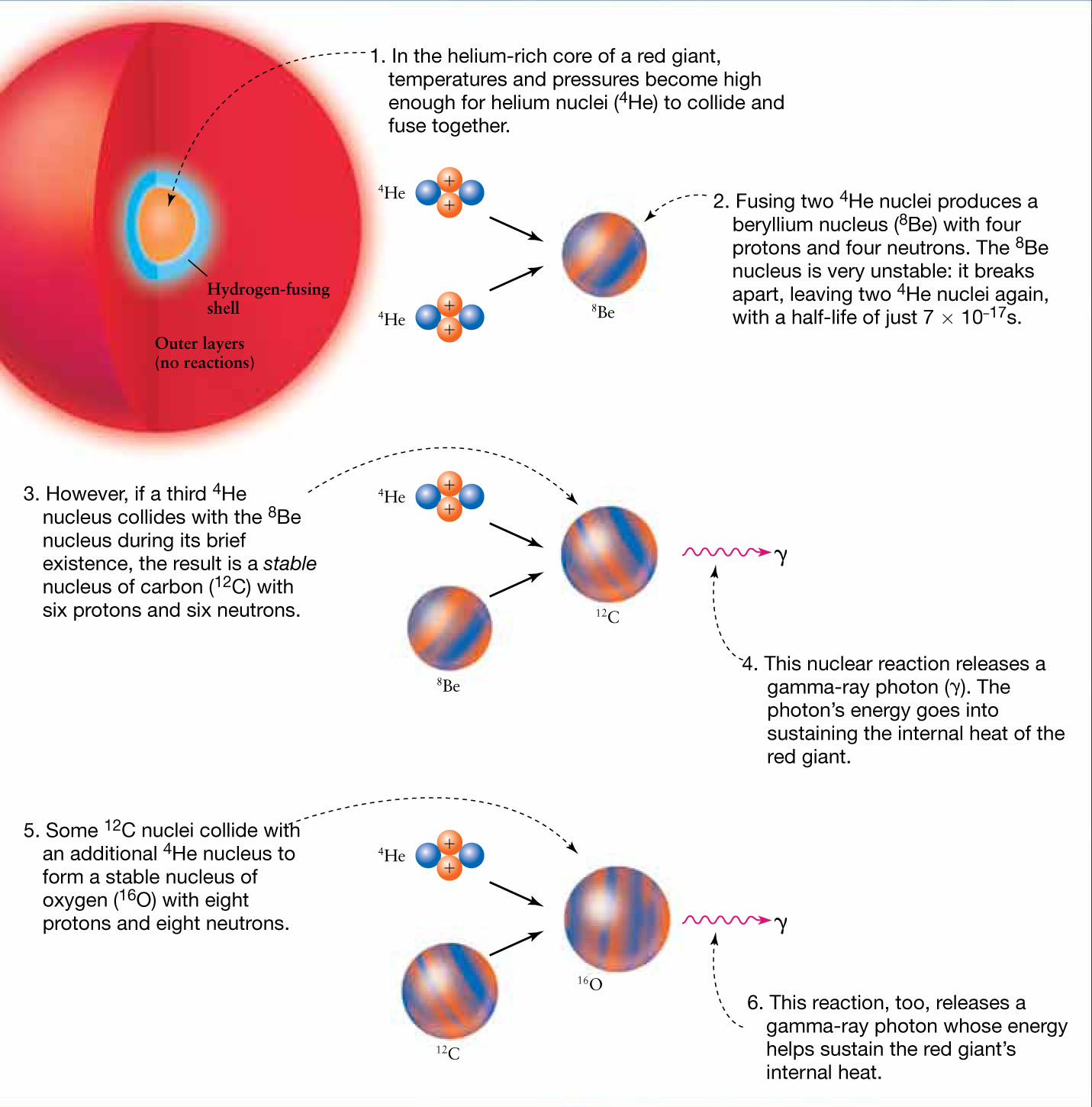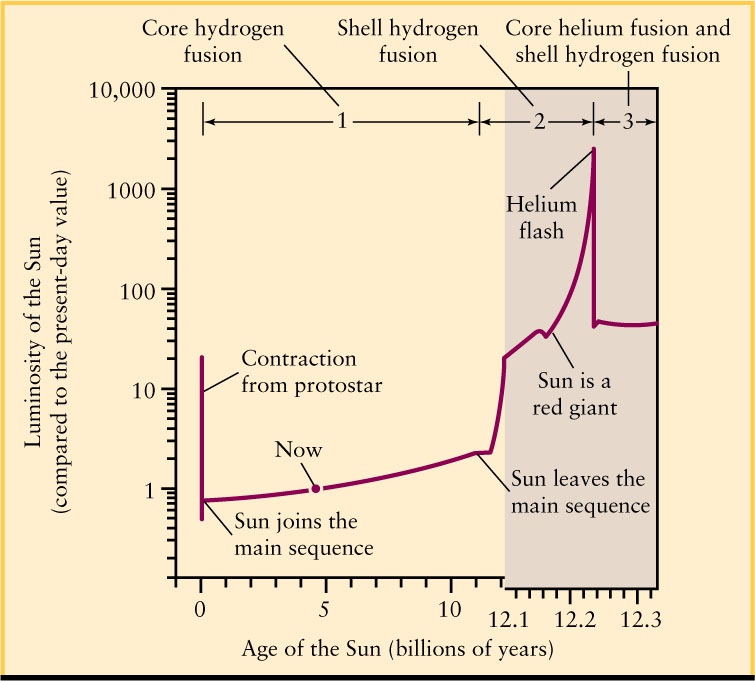19-3 Fusion of helium into carbon and oxygen begins at the center of a red giant
When a star with a mass greater than 0.4 M⊙ first changes from a main-sequence star (Figure 19-6a) to a red giant (Figure 19-6b), its hydrogen-fusing shell surrounds a small, compact core of almost pure helium. In a red giant of moderately low mass, which the Sun will become 7 billion years from now, the dense helium core is about twice the diameter of Earth. Most of this core helium was produced by thermonuclear reactions during the star’s main-sequence lifetime; during the red-giant era, this helium will undergo thermonuclear reactions.

540
Core Helium Fusion
Helium, the “ash” left over from hydrogen fusion, is a potential nuclear fuel: Helium fusion, the thermonuclear fusion of helium nuclei to make heavier nuclei, releases energy. But this reaction cannot take place within the core of our present-day Sun because the temperature there is too low. Each helium nucleus contains two protons, so it has twice the positive electric charge of a hydrogen nucleus, and there is a much stronger electric repulsion between two helium nuclei than between two hydrogen nuclei. For helium nuclei to overcome this repulsion and get close enough to fuse together, they must be moving at very high speeds, which means that the temperature of the helium gas must be very high. (For more on the relationship between the temperature of a gas and the speed of atoms in the gas, see Box 7-2.)
When a star first becomes a red giant, the temperature of its contracted helium core is still too low for helium nuclei to fuse. But as the hydrogen-fusing shell adds mass to the helium core, the core contracts even more, further increasing the star’s central temperature. When the central temperature finally reaches 100 million (108) K, core helium fusion—that is, thermonuclear fusion of helium in the core—begins. As a result, the aging star again has a central energy source for the first time since leaving the main sequence (see Figure 19-6c).
Helium fusion occurs in two steps. First, two helium nuclei combine to form a beryllium nucleus:
4He + 4He → 8Be
This particular beryllium isotope, which has four protons and four neutrons, is very unstable and breaks into two helium nuclei soon after it forms. However, in the star’s dense core a third helium nucleus may strike the 8Be nucleus before it has a chance to fall apart. Such a collision creates a stable isotope of carbon and releases energy in the form of a gamma-ray photon (γ):
8Be + 4He → 12C + γ
This process of fusing three helium nuclei to form a carbon nucleus is called the triple alpha process, because helium nuclei (4He) are also called alpha particles by nuclear physicists. Some of the carbon nuclei created in this process can fuse with an additional helium nucleus to produce a stable isotope of oxygen and release more energy:
12C + 4He → 16O + γ
Thus, both carbon and oxygen make up the “ash” of helium fusion. The second step in the triple alpha process, and the process of oxygen formation, both release energy. The pressure resulting from this energy prevents any further gravitational contraction of the star’s core. The Cosmic Connections figure summarizes the reactions involved in helium fusion.
It is interesting to note that 12C and 16O are the most common isotopes of carbon and oxygen, respectively; the vast majority of the carbon atoms in your body are 12C, and almost all the oxygen you breathe is 16O. We will discuss the significance of this in Section 19-5.
A mature red giant fuses helium in its core for a much shorter time than it spent fusing hydrogen in its core as a main-sequence star. For example, in the distant future the Sun will sustain helium core fusion for only about 100 million years—this period is only about 1% of the time that hydrogen fusion occurs. (While this is going on, hydrogen fusion is still continuing in a shell around the core.)
CONCEPT CHECK 19-4
What is different about the core of a red giant that allows helium to fuse even though this does not occur in the core of our present-day Sun?
CONCEPT CHECK 19-5
Where is a red giant hotter than it was during its main-sequence phase? Where is it cooler?
The Helium Flash and Electron Degeneracy
How helium fusion begins at a red giant’s center depends on the mass of the star. In high-mass red giants (greater than about 2 to 3 M⊙), helium fusion begins gradually as temperatures in the star’s core approach 108 K. In red giants with a mass less than about 2 to 3 M⊙, helium fusion begins explosively and suddenly, in what is called the helium flash. Table 19-2 summarizes these differences.
| Mass of star | Onset of helium fusion in core |
|---|---|
| More than about 0.4 but less than 2–3 solar masses | Explosive (helium flash) |
| More than 2–3 solar masses | Gradual |
| Stars with less than about 0.4 solar masses do not become red giants (see Section 19-2). | |
The helium flash occurs because of unusual conditions that develop in the core of a moderately low-mass star as it becomes a red giant. To appreciate these conditions we must first understand how an ordinary gas behaves. Then we can explore how the densely packed electrons at the star’s center alter this behavior.
When a gas is compressed, it usually becomes denser and warmer. To describe this process, scientists use the convenient concept of an ideal gas, which has a simple relationship between pressure, temperature, and density. Specifically, the pressure exerted by an ideal gas is directly proportional to both the density and the temperature of the gas. Many real gases actually behave like an ideal gas over a wide range of temperatures and densities.
Under most circumstances, the gases inside a star act like an ideal gas. If the gas expands, it cools down, and if it is compressed, it heats up (see Box 19-1). This behavior—like a safety valve—has a stabilizing influence, ensuring that the star neither collapses nor explodes (see Section 16-2). For example, if the rate of thermonuclear reactions in the star’s core should increase, the additional energy releases heat and expands the core. This expansion cools the core’s gases and slows the rate of thermonuclear reactions back to the original value. Conversely, if the rate of thermonuclear reactions should decrease, the core will cool down and compress under the pressure of the overlying layers. The compression of the core will make its temperature increase, thus speeding up the thermonuclear reactions and returning them to their original rate.
541
COSMIC CONNECTIONS
Helium Fusion in a Red Giant
A star becomes a red giant after the fusion of hydrogen into helium in its core has come to an end. As the red giant’s core shrinks and heats up, a new cycle of reactions can occur that create the even heavier elements carbon and oxygen.

542
Before helium fusion begins in a red giant’s core, the helium gas there behaves like a metal
In a red giant with a mass between about 0.4 M⊙ and 2–3 M⊙, however, the core behaves very differently from an ideal gas. The core must be compressed tremendously in order to become hot enough for helium fusion to begin. At these extreme pressures and temperatures, the atoms are completely ionized, and most of the core consists of nuclei and detached electrons. Eventually, the free electrons become so closely crowded that a limit to further compression is reached, as predicted by a remarkable law of quantum mechanics called the Pauli exclusion principle. Formulated in 1925 by the Austrian physicist Wolfgang Pauli, this principle states that two electrons cannot simultaneously occupy the same quantum state. A quantum state is a particular set of circumstances concerning locations and speeds that are available to a particle. In the quantum world of electrons, the Pauli exclusion principle is analogous to saying that you can’t have two things in the same place at the same time.

Degenerate Electrons In an ordinary piece of metal, like the chrome grille on this classic car, the electrons are affected by the Pauli exclusion principle. The resulting degenerate electron pressure helps make metals strong and difficult to compress. A more powerful version of this same effect happens inside the cores of low-mass red giant stars.
Just before the onset of helium fusion, the electrons in the core of a low-mass star are so closely crowded together that any further compression would violate the Pauli exclusion principle. Because the electrons cannot be squeezed any closer together, they produce a powerful pressure that resists further core contraction.
This phenomenon, in which closely packed particles resist compression as a consequence of the Pauli exclusion principle, is called degeneracy. Astronomers say that the electrons in the helium-rich core of a low-mass red giant are “degenerate,” and that the core is supported by degenerate-electron pressure. This degenerate pressure, unlike the pressure of an ideal gas, does not depend on temperature. Remarkably, you can find degenerate electrons on Earth in an ordinary piece of metal (Figure 19-7).
When the temperature in the core of a low-mass red giant reaches the high level required for the triple alpha process, energy begins to be released. The helium heats up, which makes the triple alpha process happen even faster. However, the pressure provided by the degenerate electrons is independent of the temperature, so the pressure does not change. Recall that an ideal gas’s increase in pressure with temperature acted as a stabilizing influence in the core. Now, without the “safety valve” of increasing pressure, the star’s core cannot expand and cool. The rising temperature causes the helium to fuse at an ever-increasing rate, producing the helium flash.
Electrons also lose their degeneracy at even higher temperatures. Eventually, the temperature becomes so high that the electrons in the core are no longer degenerate. The electrons then behave like an ideal gas and the star’s core expands, terminating the helium flash. These events occur so rapidly that the helium flash is over in seconds, after which the star’s core settles down to a steady rate of helium fusion.
CAUTION!
The term “helium flash” might give you the impression that a star emits a sudden flash of light when the helium flash occurs. If this were true, it would be an incredible sight. During the brief time interval when the helium flash occurs, the helium-fusing core is 1011 times more luminous than the present-day Sun, which is similar to the total luminosity of all the stars in the Milky Way Galaxy! But, in fact, the helium flash has no immediately visible consequences—for two reasons. First, much of the energy released during the helium flash goes into heating the core and terminating the degenerate state of the electrons. Second, the energy that does escape the core is largely absorbed by the star’s outer layers, and must work its way slowly to the surface (just like the Sun’s present-day interior; see Section 16-2). Therefore, the explosive drama of the helium flash takes place where it cannot be seen directly.
The Continuing Evolution of a Red Giant
Whether a helium flash occurs or not, the onset of core helium fusion actually causes a decrease in the luminosity of the star. This decrease is the opposite of what you might expect—after all, turning on a new energy source should make the luminosity greater, not less. What happens is that after the onset of core helium fusion, a star’s superheated core expands like an ideal gas. (If the star is of sufficiently low mass to have had a degenerate core, the increased temperature after the helium flash makes the core too hot to remain degenerate. Hence, these stars also end up with cores that behave like ideal gases.) Temperatures drop around the expanding core, so the hydrogen-fusing shell reduces its energy output and the star’s luminosity decreases. This temperature decrease allows the star’s outer layers to contract and heat up. Consequently, a post–helium-flash star is less luminous, hotter at the surface, and smaller than a red giant.
543
Core helium fusion lasts for only a relatively short time. Calculations suggest that a 1-M⊙ star like the Sun sustains core hydrogen fusion for about 12 billion (1.2 × 1010) years, followed by about 250 million (2.5 × 108) years of shell hydrogen fusion leading up to the helium flash. After the helium flash, such a star can fuse helium in its core (while simultaneously fusing hydrogen in a shell around the core) for only 100 million (108) years, a mere 1% of its main-sequence lifetime. Figure 19-8 summarizes these evolutionary stages in the life of a 1-M⊙ star. In Chapter 20 we will take up the story of what happens after a star has consumed all the helium in its core.

Here is the story of post–main-sequence evolution in its briefest form: Before the beginning of core helium fusion, the star’s core compresses and the outer layers expand, and just after core helium fusion begins, the core expands and the outer layers compress. We will see in Chapter 20 that this behavior, in which the inner and outer regions of the star change in opposite ways, occurs again and again in the final stages of a star’s evolution.
CONCEPT CHECK 19-6
What is the “safety valve” in a main-sequence star’s nuclear reactions, and how is it not in place for a red giant with a core supported by degenerate-electron pressure?
CONCEPT CHECK 19-7
What happens to the luminosity when the helium-fusing core is no longer supported by degenerate-electron pressure?